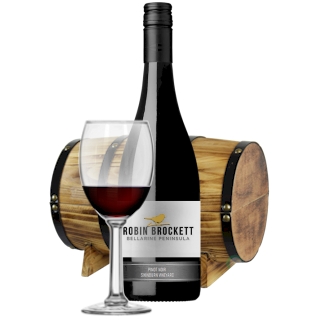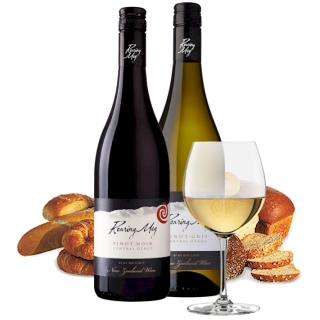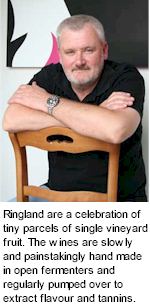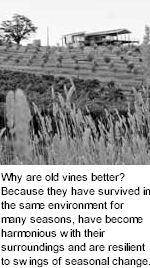


Ringland has worked at the eminent Rockford in Barossa, as well as for distinguished estates in Spain, Italy and America. Although he lived in the Barossa since the early 1980s, he was fortunate enough to purchase a property on the Barossa Ranges in 1994. At 1,500 ft above sea level, Chris Ringland has taken his time to restore the seven acre site which was planted in 1910. It took ten years. When he purchased the property, the northern, southeast facing sector, surrounding the old settlers cottage, was bare pasture. Ringland grazed sheep here for a few years, before planting 250 olive saplings in 2000, with the view of producing small amounts of olive oil. Dry grown, they have produced under 100 litres of olive oil in their lifetime. There is nothing quite as satisfying as home grown olive oil. Home grown Shiraz beats it, but not by all that much.

The old Barossa Settlers cottage on the property eventually had to go, so in 1998, he started planning a building project, culminating in 2005, with a house built to encompass the surroundings. The glass and straw bale residence was designed by Bohdan Dorniak and built by Tom Mikulic. The site of the original settlers cottage was really the best spot on the property for the new house, so it was demolished and excavated into an enormous hole, which was to become the underground maturation cellar for Chris Ringland Shiraz. Half of the excavation was also devoted to a massive underground rainwater tank. The 60,000L storage capacity also acts as a superb thermal stabiliser for the wine cellar, which maintains a year round temperature of between 13-18 degrees Celsius.
After ten years of pruning and re-trellising, the ancient vines got back into sustainable shape. Because South Australia was never touched by phyloxera, thanks to a 120 year quarantine by the wine industry, the vines survive on their own roots. This enables them to attain a great age, while still remaining productive. As the most senior vines begin to decline, they are rejuvenated with younger growth material through the ancient technique of layering. Thus, the original root systems are maintained.
Why are old vines better? It is simply because they have survived in the same environment for so many seasons. They have become harmonious with their surroundings and strongly resilient to the swings of seasonal change. The roots extend deep into the underlying decomposed podzolic clay, which stores moisture during the summer months, eliminating the need for irrigation.

In addition, the pond at the bottom of the vineyard acts as a passive water source, supplying the underlying soil strata with moisture. The pond is also a superb yabby dam, think crawfish with nippers, which provide a delicious annual feast for the grape pickers. It's also home to a considerable population of frogs, which keep Ringland awake on summer nights. On a clear day it is possible to see the spire of the church on Henschke's Hill of Grace.
The average annual rainfall is around 750mm, although seasons can be unusually dry. It might sound a bit cliché, but, just like the watch advert, you never really own an ancient Shiraz vineyard, you are merely it's custodian for the next generation. In some seasons the fruit will naturally ripen up to 17° Baumé yet retain excellent acid balance and flavour. Ringland wines really are a celebration of tiny parcels of true vineyard selected fruit. The wines are painstakingly hand-made in open fermenters and regularly pumped over to extract colour, flavour and tannins. After draining and pressing through a traditional wooden basket press, fermentation is completed in 100% new French oak hogsheads. A period of up to 46 months oak maturation follows to achieve optimum complexity and balance between oak and fruit. Ringland generally leaves the ageing barrels alone believing that a laissez-faire approach will allow the tannins and oak to harmonise.
To sustainably manage his vines, Ringland believes that less is better and he generally doesn't disturb the soil with tillage. He prunes the vines hard and feeds them gently during the growing season with a spray of natural nutrients. As soon as grapes begin to colour, the entire vineyard is covered with bird net, to prevent damage to the fruit and to enable it to achieve full ripeness in pristine condition.
